In addition to having finished the buttons for it, I’ve got my 1370ish medieval gown all sewn together:
Actually, it’s been sewn together for almost two weeks now, but I’ve been busy working and making class samples (one seen in the photo with me) and having events and generally living life, and haven’t been able to do much work on it.
To sew it, I cut a linen lining for the bodice (using a great piece of vintage linen with very little give), flat lined the bodice sections, and sewed the dress together.
I’m doing all the main seaming with machine sewing, because between winter chillblains and arm stress extensive hand-sewing will just be too painful this time of year. I know it won’t be totally historically accurate this way, but I also know even if I did hand sew it probably wouldn’t be totally historically accurate anyway.
I’m thinking of this as a learning garment — a working toile if you will. I know I won’t get it all right, but I also know this is the most effective way for me to learn a lot, so that the next time I will.
The first fitting definitely had a few fit-ssues. Far too much fabric in the bodice to support me, wrinkles across the torso, and the whole bodice was sitting too low. (side note: I had no idea what the HA way to finish the bottom of a linen lining was, so I just folded it up and stitched. At least it’s on the inside!)
And terrible, terrible back wrinkles. The back and torso wrinkles are mostly about it being too snug in the wrong places, so they can be fixed by re-adjusting seam allowances (thank goodness I used 1.5cm seam allowances!).
The big issue I needed to fix before tackling those was the too-low bodice, which I fixed with the simple expediency of raising the shoulder seams, and re-cutting the armholes. I’ll still need to finesse the neckline when I get to finishing, but that’s a fair way off.
Raising the armholes also re-adjusted the tightness around my torso, which helped a bit with the back wrinkles, though there are still a few:
 In addition to the obvious fitting issues of ‘this is too baggy in this spot / too tight in this’ I’m also really trying to think about how a medieval dress actually fits a body, as opposed to how we think clothes should fit the body – as period fit is not necessarily modern fit, for any period.
In addition to the obvious fitting issues of ‘this is too baggy in this spot / too tight in this’ I’m also really trying to think about how a medieval dress actually fits a body, as opposed to how we think clothes should fit the body – as period fit is not necessarily modern fit, for any period.
In looking at inspiration when I first embarked on medieval clothing I quickly decided I preferred the fashions of about 1370-80, because the earlier 14thc is very sack-y, with little shaping, and the early 15th century is very curv-y and bust-y, which I am not.
Basically I looked at Katherine’s effigy and thought ‘yep, that’s my body’ (sorry, not the best photo to show her whole body shape):
Then I looked at the more fashionable lady in blue in this image, and though “It is just not possible to show off that much of my bust and still have any curve – red lady is way more realistic”

Guillaume de Machaut watching the disappointed lover. РThe Judgement of the King of Navarre. Mątre Policratique . 1380-1395
So I had a vague idea of shape changes in the 14th century from sack to flat to boob-a-thon, with corresponding lowering necklines, and knew I was going for option B simply because it fits my body best, and my (admittedly) modern sensibilities, which aren’t quite ready for wool sack (though I think I’m going to develop a love of wool sacks very quickly!).
I didn’t really analyse my observations any more than that, until Panth commented that I should look closely at the silhouettes in images (well worth it to scroll down and read the comments). In doing so, I found her amazing blog post series on the 14th century bust shape (well, well worth it to read the whole series).
Her blog post answered so many of the questions I had about bust fit. Most of the bloggers who have done 14th century extensively and blogged about fitting and pattern draping are quite busty women, and while they talk about bust support and fit, it wasn’t always clear to me what was period, and what was their desire to support their bust. It is just not possible for me to have a lifted bust, with cleavage, and outward curve. I can, however, very effectively have a quite androgynous torso, with just a hint of bust and waist. Beyond fit, I just have a fashionable 1370s body, rather than a fashionable 1390s body.
Panth’s posts have given me a clear set of guidelines as I get to the final fit, so that I (hopefully) produce something that matches a specific 14th century set of ideals and silhouette, not a modern interpretation based on our ideals of fit and silhouette.
At this point, though there are still fit-sues, I’m ready to finish the front opening edge, and to sew the lacing holes. With that done, I can finesse the final fit, finish the neckline, set the sleeves, do endless amounts of interior seam finishing, and equally endless amounts of hemming.
I’m pretty sure that the correct way to finish the front opening (other than tablet weaving, which I’m not going to attempt, and which, while it is period, doesn’t seem to have been universally used by any means, so skipping it is not cheating) is to turn the wool and linen in towards each other, so that raw edges are hidden, and then sew.
Anyone know if a stab stitch or whipstitch would be more accurate? I have poured through my sources and can’t find the answer.

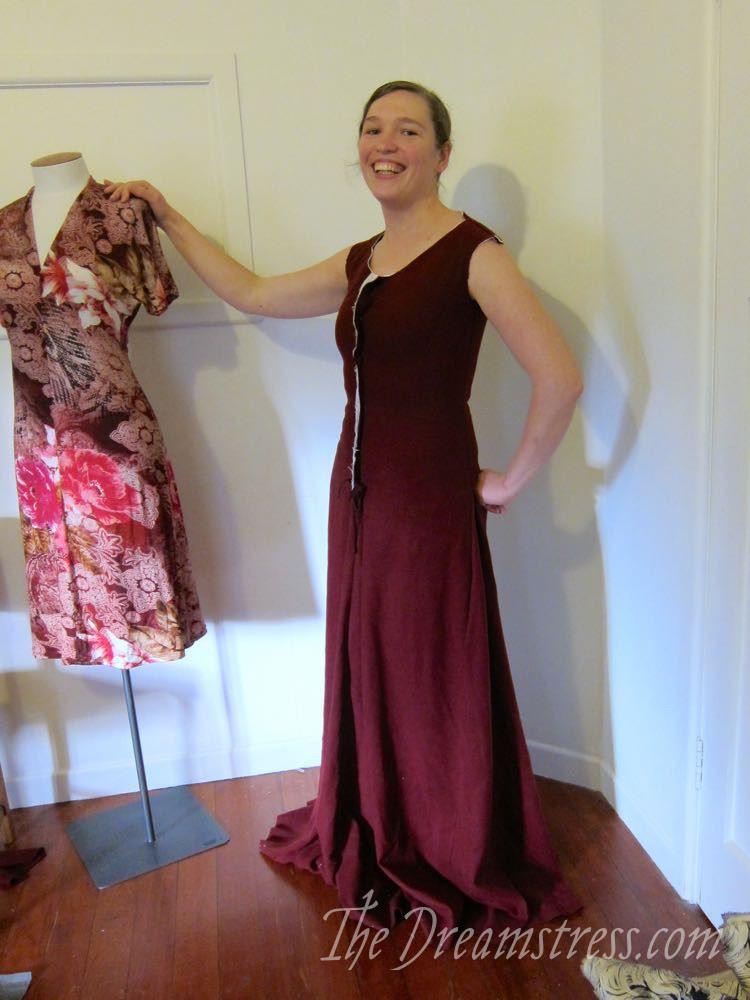
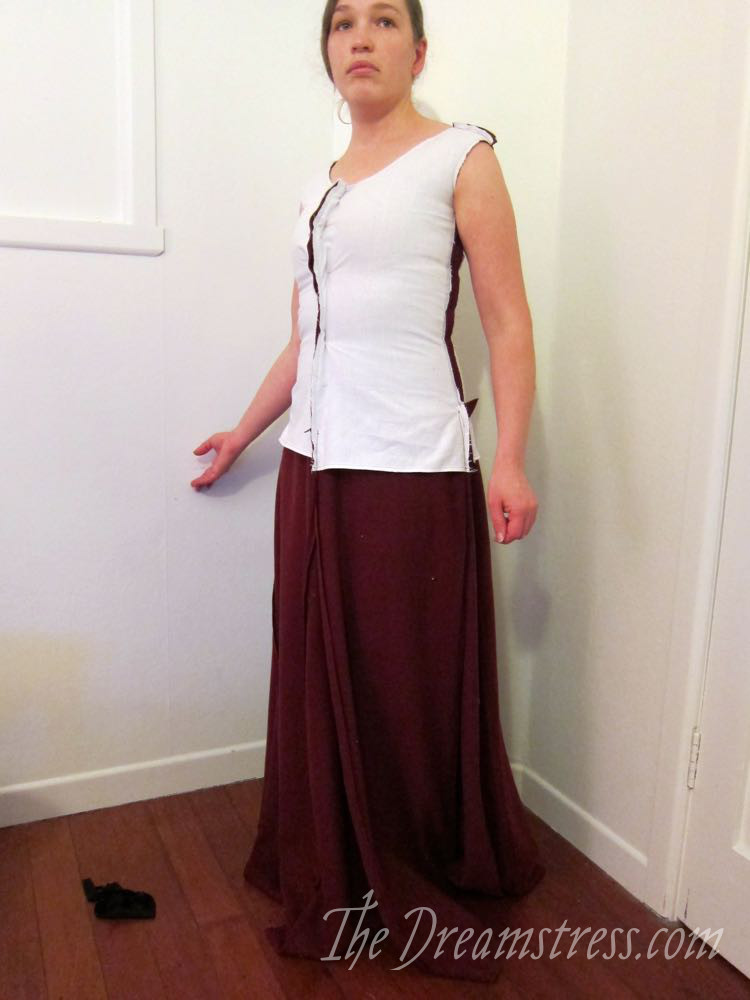
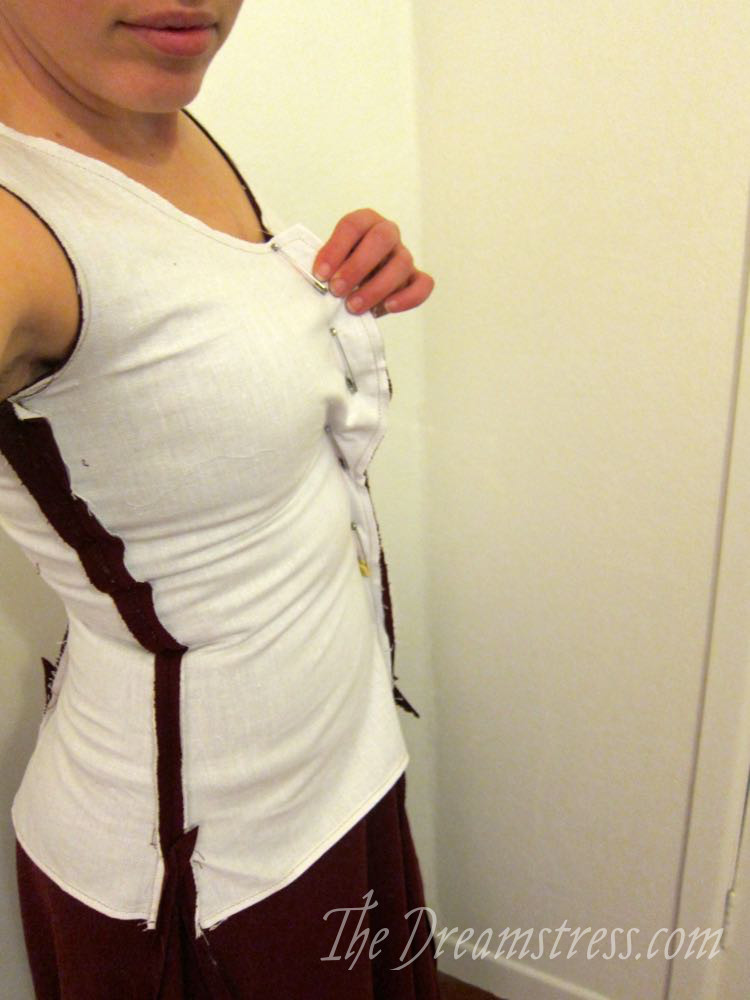
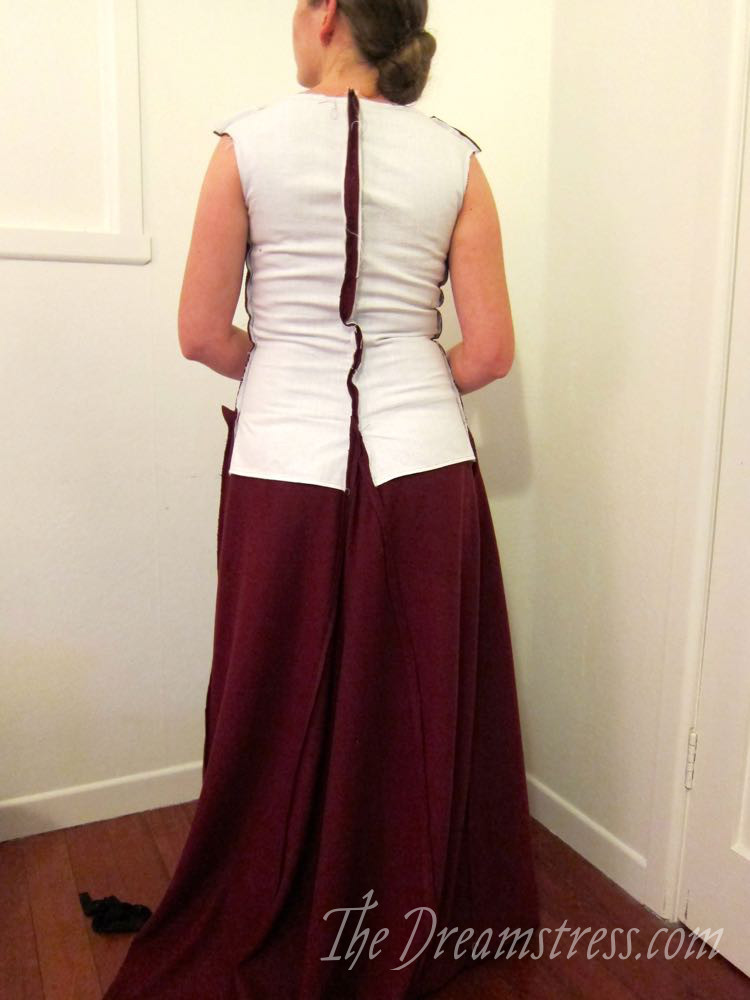
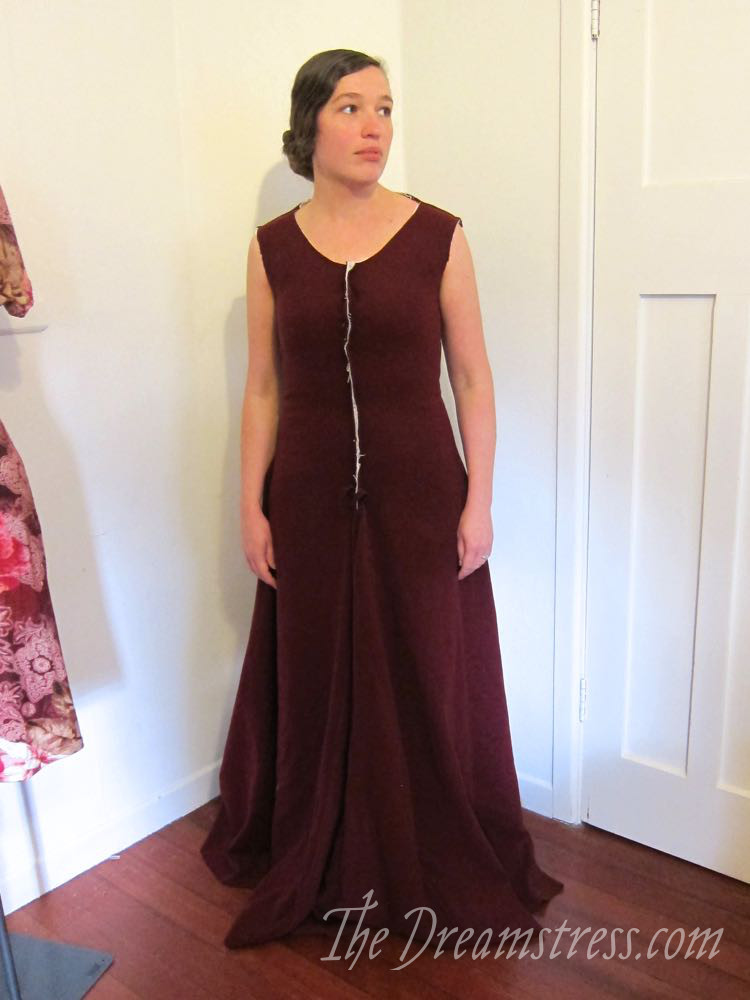
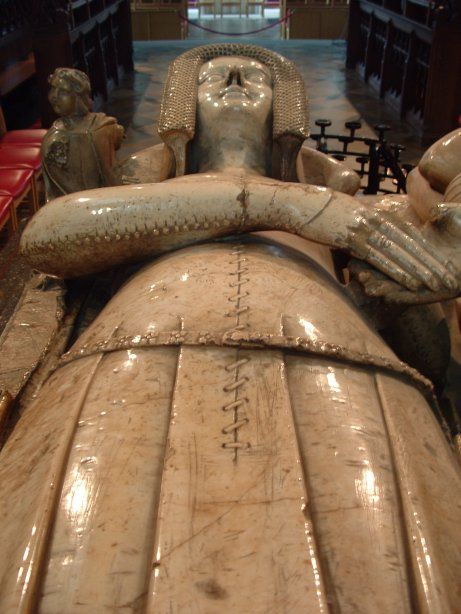
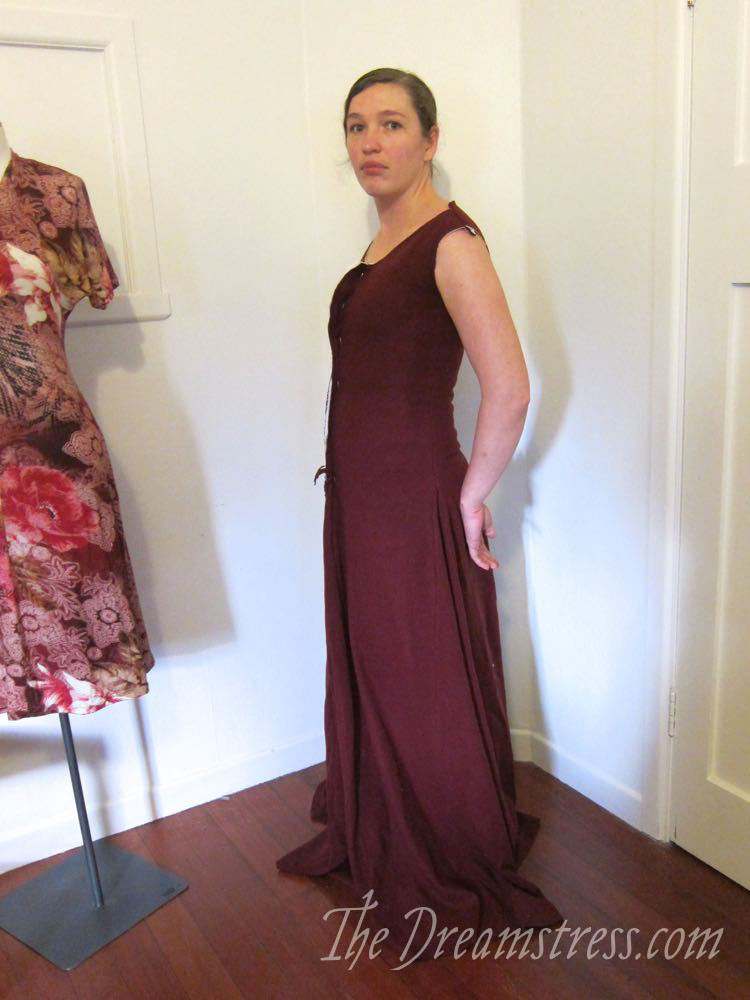

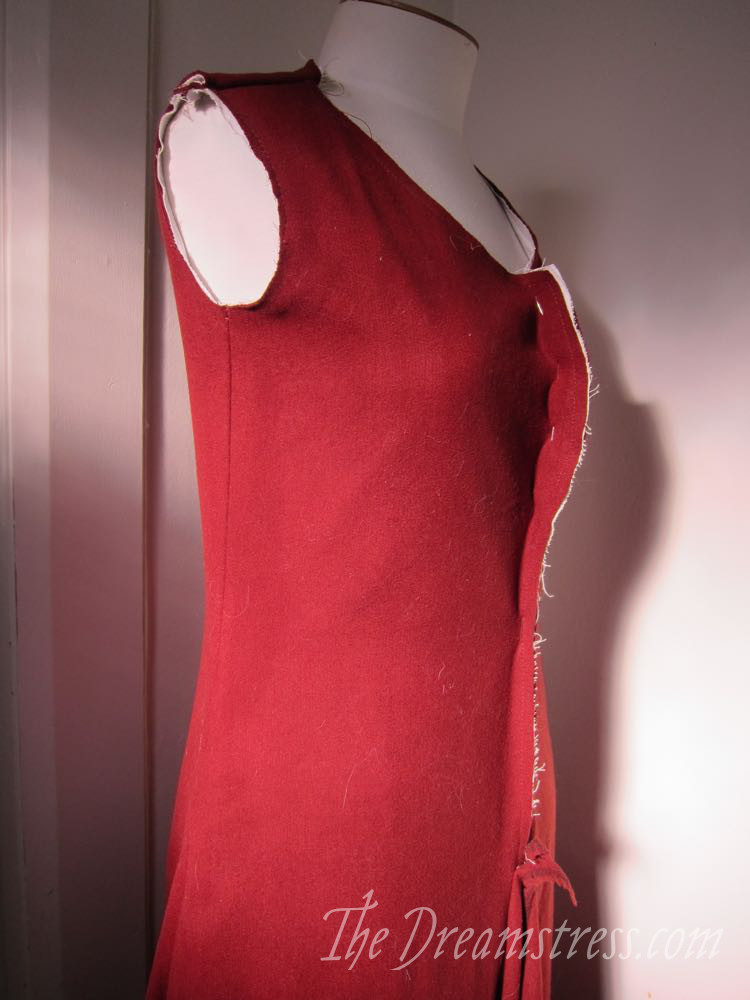
Leimomi, I had to chuckle while reading this article & then your bio. We have SO much in common, yet I’m old enough to be your mother! I began sewing when I was 11 years old, made my own clothing through high school & have sewn ever since. I started out my career in nursing; got my degree, put in my time & left the hospital 15 years ago, never looking back. I worked for four years in an established art museum in Western New York, in the Education Dept., first as a docent, then as a docent trainer. This allowed me to do lots of research & I created a “costume art” tour for the gallery that became a big hit. While working at the gallery, I dabbled in sewing for the theater. Upon leaving the gallery, I was lucky enough to stumble on what would be the “dream job” of my life. I spent the last 15 years working in the Theater & Dance Department of a local university in the Costume Shop. There I worked on making historically accurate costumes (within reason) for the stage & costumes for Dance Dept. productions. I was in heaven! My boss & co-worker were gifted in different areas; as a team, we were unstoppable! In the summer, we worked on costumes for minimum wage in support of Shakespeare in the Park. I learned SO much in my last two jobs! So I, too, came to my costume expertise in a roundabout way. It is a part of who I am & probably the happiest time in my life. A year ago, my husband & I moved cross country to Sacramento, CA, where we awaited the birth of our first grandchild, a girl, last September. Unfortunately, I’ve not tried to find a position here, as I am babysitting my granddaughter. I miss the theater so much, but I just couldn’t bear the thought of “My little girl” in day care, and so that’s what I’m doing today.
I love your blog & love the analysis of historical clothing, fabrics & accessories. At least if I can’t be working in the shop, I can use my knowledge here.
My suggestion for finishing the bodice edges is to fold the seam allowances to inside (wrong sides together) for outer fabric & lining & use blind stitch to close those edges. Regular commercial thread may be strong enough for something that is not being worn or used. If it will be worn, I suggest using a stronger hand sewing thread or silk thread to give some strength to the seam. Also, as far as historical style goes for that period, in terms of fit, shouldn’t we consider that these gowns were usually worn over a corset & chemise of some sort? Not sure if that was the case for the upper classes, but I think it a virtual certainty for the lower classes. Discuss….
Welcome to the club of museum/theatre/costume historian blends! We’re a rare breed, but not unique – it’s surprising how many I run across. Sounds like you had an amazing journey, and some great experiences! I do miss the theatre hugely too (though, of course, time blurs the memory of the stress and the more ‘artistic’ personalities one encountered!). There was so much vibrancy and creativity, and energy with a performance on. And working with a good team is amazing.
I don’t want to use a blind stitch to close the front edges, because it’s a very weak stitch for an edge that is going to get a lot of stress, and it’s also not a stitch for which I can find much medieval evidence. And a good whipstitch or pick-stitch (and boy, can I do a good whipstitch!) will be almost invisible anyway.
The gown will definitely be worn over a chemise, but boned, supportive undergarments (the precursors of what we would today call a corset) don’t make an appearance until the 16th century (late 15th at the very earliest), so they definitely weren’t worn with gowns like this by any level of society.
I don’t know if you have seen it, but I have made a late 16th century pair of bodies.
What a lovely history you have! Also, your little girl will be very lucky to have a talented and skilled grandmother around her who can help flesh her imaginations and fantasies into a clearer reality through costuming!
I owe much of my mind to having learned how to sew, early. Art, construction, holistic design, problem-solving, engineering, math, perseverance, importance of detail (even though I hate paying attention to details!) all are taught through sewing, and all so important for children to learn–especially for girls as it opens up abilities important to STEM fields!
And thank you for helping your daughter. I am a working mum who would be very unhappy and depressed at home. While I heartily approve of daycare, I also heartily approve of all healthy ways to enable women to achieve their dreams–at work or at home! Quality childcare–I think–is the most important thing that we can do for women!
It looks amazing! Well done getting it to fit so well.
Thank you! The fit is all due to the awesome drapers! It’s amazing what having someone else to help can do!
Looking good! (And um, thanks for the endorsement. *embarrassed* I’ll admit to writing that series of posts when I was feeling rather ranty, hence why I don’t normally link to it. However, I’m glad you found them useful!)
Re. linen lining, I tend not to do the half-lining thing (it’s part of Robin Netherton / etc.s “gothic fitted dress” method rather than any historic evidence for/against). In my (limited) experience you can get away without it if you use sufficiently good wool and/or aren’t massively busty and/or doing the lift-and-cup late 14th C silhouette and/or use other bust support underneath (bra-shift, Lengberg bra, binding, etc.).
Re. the front edge, I can’t think of any extant lined garments earlier than the late 15th C. The tablet woven edging is found on edges with button-holes in the London finds, but those were wool garment with silk or (presumed, now absent) linen facings and silk or (presumed, now absent) linen edging. Tablet woven edging is also found on hems and protecting seam allowances of the Greenland finds – those are wool fabric (vadmal) with wool edging and are unlined and, in the case of the hems, there’s singling (basically, running stitches in a sine-curve to help discourage fraying) too but no actual turned hem. Both running and whip stitches are know archaeologically from medieval finds, so either would be ok, I guess. From both London and Greenland we have evidence of putting a tiny row or double row of stab-stitches along necklines (London: double row, attaching a narrow (5mm!) silk facing; Greenland: single row (IIRC), angled so it looks like Holbein stitch when finished). Also, one of the London buttoned sleeve remnants has the end of the cuff hemmed using tiny running stitches.
Sorry, that should be: “and/or AREN’T doing the lift-and-cup late 14th C silhouette…”
I think it’s quite good to have the occasional ranty post! The costuming community can be a bit ‘extremely nice’ in that we feel we have to say “oooh pretty!” to everything and don’t question the decisions and assumptions that other costumers (especially the really established ones) make enough, for fear of being called a garb snark (granted, we’re 1,000,000 times better than the online sewing community about that), and you weren’t at all rude or mean. You simply pointed out that there is a lot of period evidence that contradicts some of the established ‘do this’ methods, and posed a lot of questions we really should think about. And provided basically the best overview of silhouette changes in the 14th c out there (I know, because I looked and looked after your comment!)
I will admit that I regretted the lining almost the minute I put the dress on, and quickly realised it probably isn’t period – despite being advocated by many established costumers for this period. I’m debating taking it out, but my wool is very stretchy, and that would be a lot of unpicking… Basically I’ve decided I’m going to spend the weekend focusing on finishing all the other pressing UFO sewing I have on (1910s corset cover, Vionnet dress, two toddler dresses) and then make my final decision about unpicking vs. not unpicking the lining.
I’m pretty sure the Golden Gown of Queen M what’s-her-face was lined in linen in the torso though. And it’s 14th c? No? Must go check on my notes on that…
If I do take out my lining, as long as I’m doing acres of unpicking, should I also raise my gores? I’ve got enough hem to take them up a couple of inches, and I wonder if it would be better if they started higher on my hips. Especially the side and back ones…
The tablet weaving comment is because EVERYONE (except Sarah) seems to be doing it for everything these days, but there are plenty of items that don’t have it.
Oh, one more quick remark. I was thinking, even before I saw this comment, that if you raised the back gore it would help with the fit through the small of the back.
Yes, I would raise the gores. I (and most 14th century women I know) put them as high as the natural waist actually.
And no, I don’t do the tablet woven edges on everything on principle. I’ve done it on hubby’s buttoned sleeves where – hey – there is actual evidence of the practice.
And so far I haven’t lined my bodices, though being rather top heavy. Even without supportive underwear, a tight dress over an ordinary shift works well enough. I’m meaning to see what restraining bust support I can find though, that will still work with breastfeeding, because simple binding just won’t.
Thank you! Based on looking at it and your advice I am going to raise the gores, but not as far as my waist, because with my hip flare, even in really draping fabric, if I raise the gores all the way to my waist I’ll get that really late 14th c bust-waist-hips look, rather than the more androgynous 1370s look I’m going for. And my stomach will be totally hidden, whereas you can clearly see the stomach curve in some of the images, which (although they were working towards an ideal of visible fertility) is something you’d only see on my very high-waisted body if there is a bit of tightness around the upper hips and stomach.
I did find that one of the huge weaknesses in the ‘drape your own gothic dress’ tutorials is that none of them gave any clear (or really, even vague) indication of how far up the gores should go.
personal.utulsa.eduThe golden gown of Queen Margareta, in Uppsala Cathedral. I remembered it as soon as I went to bed! It is indeed lined in linen in the bodice, but there is the big question about dating – is it 14th or 15th century?
reconstructinghistory.comI’m a scientist in the real world, so I guess I figured a somewhat ranty series of posts with a whopping load of evidence and some open-minded questions was the best way of going about things. Glad it was useful!
The lining, yes, I did vaguely think of Queen Margareta’s dress but didn’t double-check and look it up. I wonder about that one – partly the dating but also because it’s visibly been altered to fit a smaller person (or, at least that is the favoured interpretation for the shaping of the waist/hips area – the hypothesis being that the torso was taken in drastically but, as the skirt was cut as one rather than with gores, it was just fudged to widen dramatically where the skirts start).
Totally agree with the comment about tablet weaving. There are trends (reenactorisms) for things – used inappropriately and/or far too often. It’s kind of interesting watching them wash through the blogging/SCA/reenacting circles. The old ones that have mostly lost popularity now were top-stitched seams (see: https://www.reconstructinghistory.com/articles/medieval-articles/an-unseamly-mistake-seam-topstitching.html), “Luttrell Psalter style” smocked aprons, krussler/pleated veils and brickstitch purses. The current ones seem to be tablet-woven edging and Greenland-style seams felled with filler threads (see: https://katafalk.wordpress.com/2014/08/18/the-brown-greenland-gown/). Wonder what will be next!
(P.S. I agree with Sarah and the others about the gores. I, too, often put them close to or at natural waist. They’re ok a bit further down provided one hasn’t taken the “gothic fitted dress” thing too far. There does seem to be a tendency (perhaps due to the recommendation to pattern using a toile that comes down to hip-height?) to make them with negative ease until the low hip region which, IMO, often gives a strange tension line where the garment changes from negative to positive ease.)
This is so interesting! Reenactors have trends, and micro-fashions, and I’m fascinated. Thank you for opening up that world!
What is tablet weaving? Why the hate on the gothic dress?
Very roughly (especially since I’m not an expert) tablet weaving is a very old method of weaving that was used to finish the cuff and other edges of some medieval garments.
Sarah blogs about it a bit here: http://amostpeculiarmademoiselle.blogspot.co.nz/2011/05/tablet-woven-edge.html
And here is Katafalk’s post with very detailed images of doing it along the edge of a hood:
https://katafalk.wordpress.com/2013/04/04/open-hood-with-card-tablet-woven-edge/
Here is the wikipedia article:
https://en.wikipedia.org/wiki/Tablet_weaving
I have no hate for tablet weaving, but when I first started doing medieval research SO MANY bloggers were posting about tablet weaving, and using it to finish the edges of all sorts of things. I felt quite overwhelmed, because it was just another technique to learn, and there was a bit of implied snobbery from (admittedly, a very few, but enough to scare me) makers about ‘oh, if you don’t do tablet weaving your garments aren’t up to HA snuff.’
Then when I did more research I realised that there are LOTS (well, lots considering how few extent medieval textiles we have) of garments without any tablet weaving, and lots of evidence that many garments were finished without it. It’s just that a few books gave clear instructions, and a few bloggers posted really good tutorials, so it became quite accessible. It’s basically the latest trend in medieval sewing, and (as Sarah points out with the awesome word ‘reenactorism’ in the post I’ll link below) it’s become far more widely represented in medieval reproductions than the extent evidence suggests it was in period.
http://amostpeculiarmademoiselle.blogspot.co.nz/2013/07/a-14th-century-buttoned-cote.html
So I don’t hate it, but I’m not ready to tackle it yet, and I’m glad that I can make a garment without it and still be sure that not having it is period!
Woah…I read the tutorial with the open hood…that’s intense. Very cool, mind, but intense. I do wonder if you didn’t need edging. After all, you talked considerably in your pet a l’air about 18th-century fabric being so robust that no hemming was needed. Maybe it is analogous to 14th-century fabric, too.
Thank you for such a considered answer.
Why the gothic dress hate, though?
I don’t see any hate for the Gothic Fitted Dress here – just a disagreement that it’s the most accurate way of doing the time period.
Oops! I realised I’ve squished your question together, and thought you were asking why I hated tablet weaving on the gothic dress, not why I hate the gothic dress – which I definitely don’t, and I don’t think Panth does either.
It’s just a thing like the tablet weaving where there has been a very established trend towards one look and way of doing things, and when you step back it becomes clear that the extremely fitted dress only existed for a few decades, but it’s used as ‘THE’ look for the whole 14th c, and people have got so obsessed with the minutiae of tree bark they have forgotten there is a whole forest 🙂
Wow that’s looking nice!
I’m one of those “busty” women, and I certainly do use my kirtles for support. So, you know, I have some definite views on relative bustiness — and since I’m almost certainly fairly far outside of the medieval ideal at almost any point you care to mention, it’s a complicated issue. Yay hormones in commercial milk.
But, but, but. There are some ideas buried here that I’d like to unpack. Probably the most important is: what is the essential nature/point of garment styling? Once you’ve met the basic functions of protection from weather and meeting community norms of decency, what are you doing? I tend to think that in the modern world we are aiming at either “correcting” our figure to a particular ideal, or else concealing our failure to meet that ideal. (Wonderbra, spanx, etc., etc., and the endless & contradictory lists of rules for what “fat” women should & shouldn’t wear.)
But when every garment (above a certain social strata, anyway) is constructed individually, and there’s not a drumbeat of pictures advertisements magazines & movies etc. keeping the ideal body shape *right in front of our faces at all times*, is that really the point? For the 14th & 15th centuries, I tend to think (and to classify periods and changes) in terms of sleekness, rather than ideal body. “Sleek” is my word for the changes that came in with the man’s cotehardie (around 1340 I believe), where we suddenly started cutting garments close to the body.
So I don’t ask if this is the “right” shape. The person is the shape they are, and I’m making a garment for, and in dialogue with, that shape. Instead I ask: Does the garment fit smoothly, without awkward bunching & wrinkling? Does the body have a sleek line, visually? Are the bouncing bits adequately contained so that the wearer can get on with whatever she’s doing, or do they slide slowly down over the course of an hour? Is the dress comfortable to wear, overall? Is it appropriately tight to the body for this period?
Each sub-period certainly has variations in neckline shape, tightness, sleeve detail, etc., and I do think that should be followed. But I don’t really think that they were as … focussed? … on an exacting adherence to an “ideal body shape” as we are. Among other things, I just don’t see the evidence for it in the surviving art.
To put it another way, rather than asking if this dress makes my boobs look like the right size, I’m more inclined to question whether this dress supports them comfortably at the right height for the general silhouette. It doesn’t sound like a big change, but it affects how I go about fitting.
I find flatlining really frustrating. The two layers of fabric don’t have the same stretch/elasticity (often even if they’re the same fiber). IF I’m using two layers (I don’t always), I fit the two layers separately, and only join them at the center front opening and the armscye. I tend to fit the lining quite severely, then I fit the outer garment more or less loosely depending on the exact visual effect I’m aiming for….
I have no useful information on sewing techniques for that front edge, sorry. I just make a seam with a good wide seam allowance on the machine and put the lacing holes through all four layers…. and I do that just as soon as I have the fit roughly correct, because it’s easier to do final fitting when the dress has the final closure in place.
My first thought upon seeing the opening pic was “Omg look at that great fit!” I wish I had more historical knowledge to help, but I can say that it looks good and accurate to my eyes!
Tegan
I don’t have time to read the whole post right now, so just a quick note to wish you good luck on finishing it! – And that “curvy and busty” is probably the reason why I’m drawn to 15th century myself, because I am. 🙂
What a beautiful dress! Your version is coming along wonderfully, and I agree that it looks like the historical examples. I never noticed it but Katherine appears to be wearing some type of cape, too. Which is fabulous.
Queen Margareta was born in 1353 and died in October 1412.
But the attribution of the dress to her wardrobe isn’t proven, so we can’t be certain those are the right dates for the dress itself.